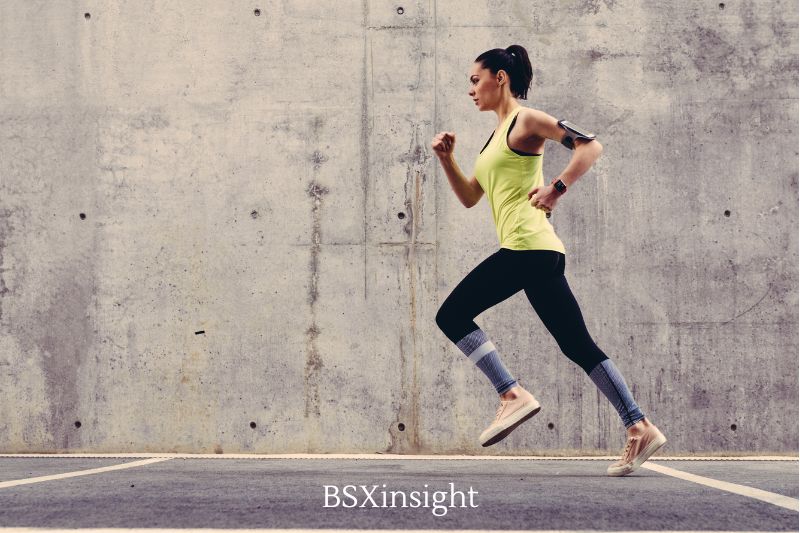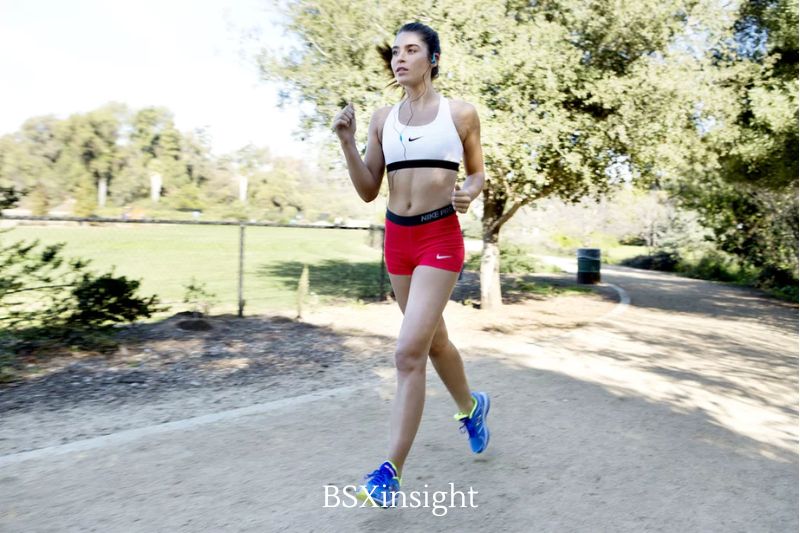- BSX Insight
The lungs are one of the most important organs in the body, and they are put to the test when running. When running, the lungs work hard to take in oxygen and expel carbon dioxide. This can lead to the lungs burning, especially if the runner is not used to running.
Read our article for more information on why lungs burn when running with BSXInsight.
Discomfort versus Pain

There is a big distinction between discomfort and pain when running. Discomfort is simply an unpleasant sensation that goes away relatively quickly, while pain is a more intense, sharp feeling that lingers.
Lungs burn when running because of the increased air intake and the corresponding increase in heart rate. The body is working harder to get oxygen to the muscles, which can lead to a burning sensation in the lungs.
Knowing The difference
It is important to distinguish between discomfort and pain when running, as pain can be a sign of something more serious.
If the pain is sharp and lasts for more than a few minutes, it is best to stop running and seek medical attention. However, if the pain is more of a dull ache or discomfort, it is likely nothing to worry about and will go away soon.
What is ‘Good Pain’?

There is a concept in an exercise called ‘good pain.’ This is the sensation of working hard and breathing heavily, but it is not the pain of injury. It is the feeling of your muscles and lungs working hard to supply oxygen to your body.
Some people enjoy the feeling of ‘good pain’ because it means they are working hard and getting a good workout. Others find it uncomfortable and prefer to avoid it.
Either way, if you are feeling ‘good pain’ when running, it means your lungs are burning because they are working hard to supply oxygen to your body. This is perfectly normal and nothing to worry about. Just keep running, and eventually, the feeling will go away.
Lactic acid
Lactic acid is produced when the body breaks down glucose for energy during exercise. It is a normal by-product of exercise and is used by the muscles for energy. However, when too much lactic acid is produced, it can build up in the muscles and cause them to feel fatigued and “burn.”
The body usually gets rid of lactic acid through the lungs, but when someone is running or exercising at a high intensity, the body can’t get rid of the lactic acid fast enough. The lactic acid then builds up in the muscles and causes that burning sensation.
There are a few ways to help prevent or reduce the amount of lactic acid that builds up in the muscles. One is to warm up properly before exercise.
This helps increase blood flow to the muscles and prepares them for activity. Another is to exercise at a moderate intensity rather than going all out.
This allows the body to build up its lactic acid tolerance gradually and prevents too much from accumulating at one time.
Finally, cooling down after exercise can also help. This gives the body time to get rid of the lactic acid that has built up. So, if you feel that burning sensation in your muscles after running, don’t worry. It’s normal. Just make sure to warm up, exercise at a moderate intensity, and cool down afterward to help prevent it.
Delayed Onset Muscle Soreness

Delayed onset muscle soreness (DOMS) is a type of muscle soreness that occurs 12-24 hours after running or another strenuous exercise. The pain usually worsens 24-48 hours after exercise and gradually improves over the next few days.
DOMS is thought to be caused by microscopic tears in the muscle tissue, which lead to inflammation and pain. It is important to note that DOMS is a normal response to exercise and is not indicative of injury.
However, if the pain is severe or lasts longer than a few days, it may be indicative of an underlying problem, and you should see a doctor. There are several ways to treat and prevent DOMS, including:
– Applying ice or heat to the affected area
– Taking over-the-counter pain medication such as ibuprofen or acetaminophen
– Doing gentle stretching and/or massage
– Taking a hot bath or using a heating pad
– Wearing compression clothing
With proper treatment, most people recover from DOMS within a week. However, some people may experience lingering soreness for several weeks. If you are concerned about your symptoms, please see a doctor.
Preventing pain
Why do my lungs burn when I run? Lungs burn when running because of the increased effort required to breathe. The airways constrict, and the lungs have to work harder to get oxygen into the bloodstream. This can cause pain in the chest and difficulty breathing.
There are several things you can do to prevent this from happening.
First, make sure you warm up before you start running. This will help loosen your muscles and make it easier to breathe.
Second, take short, shallow breaths. This will help to keep your airways open and prevent them from constricting. Finally, slow down and take a break if you start to feel pain.
New to Exercise?

If you’re new to exercise, you may be surprised to find that your lungs burn when running. This is perfectly normal and is simply your body’s way of adjusting to the new activity.
In order to avoid this burning sensation, it’s important to start slow and gradually increase your intensity.
Once your body becomes more accustomed to running, the burning sensation will subside. In the meantime, focus on taking deep breaths and staying hydrated.
Running and Asthma

Running can be difficult and sometimes dangerous for many people with asthma. They must breathe more air with every breath to supply their muscles with the oxygen needed to keep them moving. This can cause their lungs to work overtime and trigger asthma attacks.
There are a few things that people with asthma can do to help prevent an attack while running. First, it is important to warm up properly before starting to run.
This will help to loosen the muscles and prepare the lungs for increased activity. Second, it is important to run at a steady pace and not to try to go too fast.
This will help to avoid overworking the lungs. Finally, it is important to carry an inhaler with you at all times in case you do have an asthma attack.
Despite the risks, many people with asthma find they can still enjoy running and even compete in races. People with asthma can safely and effectively participate in this activity with proper preparation and care.
Talk to a Doctor
Lungs burn when running because the act of running requires a lot of oxygen to be inhaled and exhaled quickly. This can lead to a feeling of burning in the lungs, as well as coughing and shortness of breath.
If you experience these symptoms, it is important to talk to a doctor, as they may be indicative of a more serious problem.
FAQs

Why do your lungs hurt after running vaping?
Vaping is a relatively new phenomenon, and there is still much unknown about its long-term effects. However, some research suggests that vaping may be harmful to your lungs. One study found that after running, people who vaped had more difficulty breathing and experienced more lung pain than those who didn’t vape. This suggests that vaping may damage your lungs and make breathing more difficult, especially after strenuous exercise. If you’re concerned about the potential health risks of vaping, you may want to consider quitting.
Why do my lungs and throat burn when I run?
Cold, Dry Air Can Burn
The cells that line the trachea become irritated as they give up their water to humidify the air, which may cause a burning sensation in your chest and throat. There’s only so much you can do to prevent this, but staying hydrated help.
How long until you get used to running?
The key is to be consistent. You’ll definitely be sore for the first two weeks or so, but if you keep running short and slowly several times per week for a few weeks, you’ll start to feel an improved aerobic fitness kick in. Once that happens, you can gradually add mileage and pick up the pace.
How to stop my lungs from burning?
There are a few things that you can do to help prevent your lungs from burning when you run. First, make sure to warm up before you start running.
This will loosen your muscles and make it easier to breathe. Secondly, take short, shallow breaths. This will help to keep your airways open and prevent them from constricting. Finally, if you start to feel pain, slow down and take a break.
Why do lungs burn when running covid?
There are certain extreme temperatures and conditions in which running can be dangerous. Considering the coronavirus pandemic, some runners diagnosed with or recovering from COVID-19 may experience a burning sensation, tightness, or pain in their lungs.
Why does my chest burn when I run?
This is perfectly normal and is simply your body’s way of adjusting to the new activity. In order to avoid this burning sensation, it’s important to start slow and gradually increase your intensity.
Once your body becomes more accustomed to running, the burning sensation will subside.
Conclusion
If you’re experiencing chest pain and difficulty breathing during or after running, it’s important to see a doctor. There are several things you can do to prevent this from happening, including warming up, taking short, shallow breaths, and slowing down if you start to feel pain. If an asthma attack does occur, carrying an inhaler with you can be very helpful.

